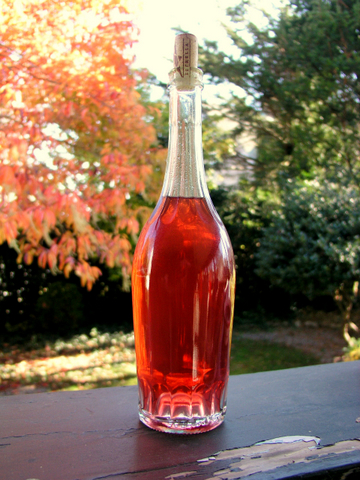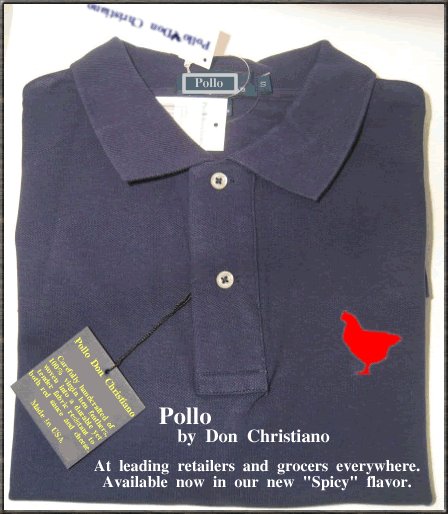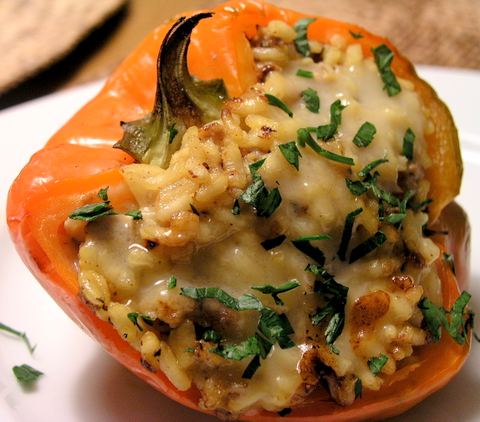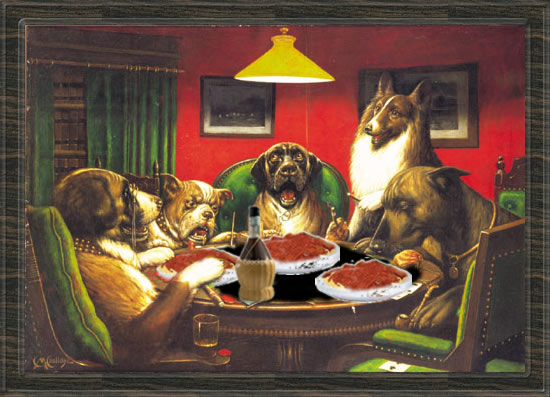White Zinfandel Vinegar
May 7th, 2007We had a shop open in downtown Mystic this past summer that, on the surface, seemed a sure hit. A local fellow thought he’d have a go at selling olive oils and vinegars. Of course, I thought this was a great idea too. I had visions of a shop like Alziari in Vieux Nice, where patrons bring their own bottles, and draw off as much olive oil as they need from one of Alziari’s massive vats. Or they bring their own containers and scoop out pounds of Piccholine, Calamata, and Sicilian Colossal olives.
Alas, our young fellow had a different strategy in mind. His turns out to be the kind of shop where Aunt Martha might go to buy a stocking-stuffer for cousin Sally who’s running around with that young Italian fellow. That is to say, a 4 oz. Bottle of olive oil of indeterminate origin that costs around $25.00.
Nevertheless, our local fellow was enthusiastic about his products, and was delighted to organize tastings on the spur of the moment. The day I visited his shop he had several bottles of vinegar on offer; among them, a bottle of White Zinfandel.
I tasted; it was fruity yet acidic; full-bodied yet mellow. I could talk about hints of blackberry, tobacco, and apricots, but the only time I’ve gotten those hints was when I tasted blackberry, tobacco, or apricots. The White Zinfandel was lovely. But at $25.00 for 750 ml. I thought I could do better.
I’ve made my own vinegar in the past. In fact, when I stayed on a vineyard in Piemonte, my host and hostess sent me home with a parting gift of Barolo mother, or vinegar starter. When I got home, I simply found a clean container, added the mother, and poured in bottle of Gallo Hearty Burgundy. Six or eight weeks later, I had some delicious red wine vinegar.
How I Did it This Time

This time, I didn’t have a mother, so I went to a health food store, and bought a quart of unpasteurized, unfiltered cider vinegar. This—I’ve been told—would do the job of turning wine into vinegar. Next, I went to my local liquor mart for a liter of Sutter Home White Zinfandel wine. Finally, I prevailed on a chef friend for an empty glass one-gallon pickle jug, and the use of her Hobart commercial dishwasher.
If you don’t have a chef friend and can’t wash your container at 192 degrees Fahrenheit, scrub your container with detergent, then rinse with a solution of one-tablespoon chlorine bleach to one gallon of water, then rinse again with warm tap water. The whole idea here is that any bugs that show up in the vinegar—and they will—should be yours, and not the previous occupant’s.
To start the process, combine the cider vinegar and the wine in a one gallon container; cover the top with a cloth, like a piece of old bed sheet. Secure the cloth with an elastic band, then store the mixture in a warm dark place. After approximately two weeks, the liquid will appear cloudy, with some milky solids forming at the bottom of the jar. This is the beginning of the mother. After approximately four weeks, the mixture should taste more like vinegar than wine. After approximately six weeks, you should have nearly one and one half liters of vinegar.
When this happened for me, I drew off approximately half of what I had, and replaced it with an equal part of Sutter Home White Zinfandel. The vinegar in the photograph represents the second round of fermentation.
At this point, I’m switching to Champagne vinegar; my friend whom I’ll call Fatima, had a bottle of indifferent German sparkling wine called Trocken that seems like a good candidate.
I’ll get back to you about this effort in about six weeks.
[ad#bottom]
Coming to a Whole Foods Store Near You
May 6th, 2007
It’s always a great day for me when my dear friend Chris checks in with the latest news from the Boston food front, but it’s a particularly great day when he includes an example of his slightly twisted expertise with graphic manipulation programs.
I’m hoping I can pick up a couple of these in time for off-season golf here in Sarasota. This is the sort of thing that could be huge; not only among the Gulf Coast foodie community, but among golfers as well.
Peperoni Ripiene con Risotto
May 6th, 2007I‘ve been encouraged to discover that besides tomatoes, peppers too are in season here on the Gulf Coast of Florida. And at $0.25 each at the open air produce market, represent a great value.
While roasting is always a good choice for bell peppers, this particular batch was colorful enough that I thought I should stuff them. But rather than use the traditional stuffing based on bread crumbs, I used a simple risotto with sausage, based on the Montovan recipe for Risotto alla Pilota.
Again, though, I wanted to keep this simple in order to keep the focus on the peppers, so rather than use chicken stock for the risotto, I simply used water.
I’ve also discovered recently that by adding the wine to the risotto last, instead of first, the risotto has a pleasant sweetness that doesn’t come through with the more traditional cooking method.
Peperoni Ripiene con Risotto
Peppers Stuffed with Risotto
Ingredients:
2 Large bell peppers
1 Tbs. Olive oil
1 Italian sausage (either sweet or hot) with the casing removed
1 Medium onion, finely diced
2/3 Cup Arborio rice
1/2 Cup dry white wine
1/4 Cup grated Pecorino Romano or Parmigiano
1 – 2 Slices sharp Provolone, shredded
4 Tbs. Flat-leaf Italian parsley, finely chopped
Preparation:
Preheat the oven to 450 F.
Slice the peppers in half lengthwise. If possible, slice through the stem as well. Remove the seeds and ribs (a grapefruit knife works well for this purpose), and discard.
Place the peppers—cut side down—on a baking pan, and then in the oven. Cook for approximately ten minutes, or until the peppers begin to wilt and caramelize. Remove from the oven and reserve.
Meanwhile, heat a sauté pan over medium heat, then add the sausage. Cook, breaking up the sausage with the back of a fork, until it has lost its pinkness, and has begun to exude some fat. Remove from the heat and reserve.
Heat another sauté pan over medium-high heat, and when hot, add the olive oil. Add the chopped onion, and sauté for three or four minutes until the onion has wilted. Add the Arborio to the pan, and sauté briefly to toast the rice.
Begin adding water to the pan, approximately 1/4 Cup at a time, stirring constantly. When one addition of water has been absorbed, add another 1/4 Cup, continuing to stir. Begin tasting the rice after approximately fifteen minutes. The grains should retain their texture, but the dish should also be creamy.
When the rice is nearly cooked, add the wine, and cook, stirring, to dissolve the alcohol. Remove the rice from the heat, and add the Pecorino or Parmigiano. Stir in the reserved sausage.
Place the reserved peppers, cut side up, on a baking pan, and spoon the risotto into each of them, just mounding the risotto slightly. Dot each pepper with the shards of Provolone, and return to the oven for five or six minutes—just until the cheese begins to bubble.
Remove from the oven and place one pepper half on each of four dinner plates. Garnish with the parsley, and serve at once.
Serves four
Dogs Eating Pasta
May 6th, 2007I‘m on record in several publications indicating that my taste in art runs toward dogs playing poker. This has become significant recently as Sarasota has a thriving, vibrant art community. I mean no disrespect for the artists of Sarasota, but so far, I have yet to visit a gallery that compares with a certain bar in downtown Sonoma, California that features the complete collection of prints by Cassius Marcellus Coolidge.
I mean who would not be moved by “His Station and Four Aces?” Or the timeless, “A Friend in Need.”
Fatima—who doesn’t believe my taste in art could be that parochial—has nevertheless been nominally supportive. “Okay…how about dogs eating pasta?” she said one day, pointing to the famous spaghetti scene from Lady and the Tramp.
I took this up with my Boston friend and graphics guru, whose taste in art runs toward penguins. He liked the idea too. I think if C.M. Coolidge were still with us, he’d be pleased himself.

[tags]C.M. Coolidge, Sarasota[/tags]



